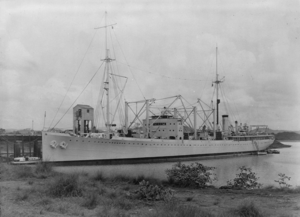
USS Wright (CVL-49/AVT-7) was a Saipan-class light aircraft carrier of the U.S. Navy, later converted to the command ship CC-2. It is the second ship named "Wright". The first Wright (AV-1) was named for Orville Wright; the second honored both Wright brothers: Orville and Wilbur.

USS Santee (CVE-29) was an American escort carrier. The second ship with this name, it was launched on 4 March 1939 as Esso Seakay under a Maritime Commission contract by the Sun Shipbuilding and Dry Dock Company at Chester, Pennsylvania, sponsored by Mrs. Charles Kurz. It was acquired by the United States Navy on 18 October 1940 and commissioned on 30 October 1940 as AO-29.

USS Anzio (ACV/CVE/CVHE-57), was a Casablanca-class escort carrier of the United States Navy that saw service during World War II in the Pacific War. Originally classified as an auxiliary aircraft carrier ACV-57, the vessel was laid down in 1942, in Vancouver, Washington, by the Kaiser Shipbuilding Company and initially named Alikula Bay, then renamed Coral Sea and redesignated CVE-57 in 1943. Coral Sea took part in naval operations supporting attacks on the Gilbert and Marshall Islands, New Guinea and the Marianas Islands. In September 1944, she was renamed Anzio. As Anzio, the escort carrier took part in assaults on the Bonin Islands and Okinawa. Following the cessation of hostilities in 1945, Anzio was among the escort carriers used in Operation Magic Carpet, returning US soldiers to the United States. Following this service, she was laid up in reserve at Norfolk, Virginia, in 1946. The escort carrier was redesignated CVHE-57 on 15 June 1955, before being sold for scrap in 1959.

USS Wake Island (CVE-65) was a Casablanca-class escort carrier of the United States Navy.
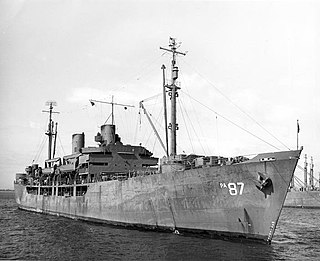
USS Niagara (APA-87) was a Gilliam-class attack transport that served with the United States Navy from 1945 to 1946. She was scrapped in 1950.

USS Wright (AZ-1/AV-1) was a one-of-a-kind auxiliary ship in the United States Navy, named for aviation pioneer Orville Wright. Originally built as a kite balloon tender, she was converted into a seaplane tender after kite balloons were no longer used.

The first USS Pyro (AE–1) was an ammunition ship of the United States Navy, commissioned from 1920 to 1924 and from 1939 to 1946. Primarily operating in the Pacific Ocean, the Pyro was present during the Attack on Pearl Harbor.
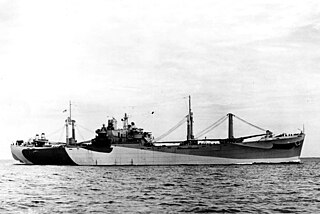
USS Akutan (AE-13) was a Lassen-class ammunition ship commissioned in the United States Navy. She was laid down on 20 June 1944 at Tampa, Fla., by the Tampa Shipbuilding Co.; launched on 17 September 1944; sponsored by Mrs. Rosswell B. Daggett, the wife of Capt. Daggett, USN, the supervisor of shipbuilding at Tampa; and commissioned on 15 February 1945. She was named after Akutan Island, an active volcano in the Aleutian Islands of Alaska.

USS Mauna Loa (AE-8) an ammunition ship in service with the United States Navy. She was commissioned from 1944 to 1947, and recommissioned between 1955 and 1958 and from 1960 to 1969. Mauna Loa was finally scrapped in 1984.

USS Rainier (AE-5), the second US Navy vessel named after Mount Rainier, was laid down on 14 May 1940 by the Tampa Shipbuilding Co., Tampa, Fla., as Rainbow ; launched 1 March 1941; sponsored by Mrs. Robert E. Anderson; transferred to the US Navy on 16 April 1941; converted for use as an ammunition auxiliary; and commissioned as Rainier (AE-5) on 21 December 1941 at Norfolk, Va..

USS Diamond Head (AE-19) was a Mount Hood-class ammunition ship in service with the United States Navy in 1945-1946 and from 1951 to 1973. She was sold for scrapping in 1974.

USS Suribachi (AE-21) was a Suribachi-class ammunition ship of the United States Navy. The ship was laid down on 31 January 1955 at Sparrows Point, Maryland, by Bethlehem Sparrows Point Shipyard, Inc.; launched on 2 November 1955; sponsored by Mrs. Lemuel C. Shepherd; and commissioned on 17 November 1956. She was named for the volcano of Iwo Jima, Mount Suribachi, the hill where the photograph Raising the Flag on Iwo Jima was taken.

USS Izard (DD-589), a Fletcher-class destroyer, was a ship of the United States Navy named for Lieutenant Ralph Izard (1785–1822),

USS Acree (DE-167) was a Cannon-class destroyer escort in service the United States Navy from 1943 to 1946. She was scrapped in 1973.

USS Shubrick (DD-639), a Gleaves-class destroyer, was the fourth ship of the United States Navy to be named for Rear Admiral William B. Shubrick.
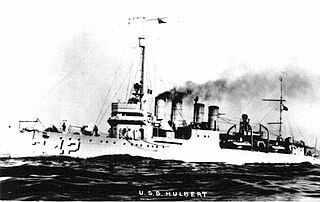
USS Hulbert (DD-342/AVD-6) was a Clemson-class destroyer in the United States Navy following World War I. She was named for Henry Hulbert.
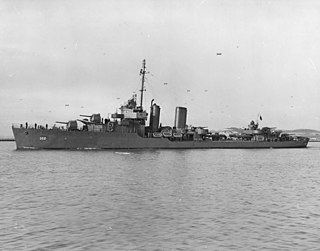
The third USS Worden (DD-352) was a Farragut-class destroyer in the United States Navy during World War II. She was named for John Lorimer Worden.

USS Fitch (DD-462/DMS-25), was a Gleaves-class destroyer of the United States Navy.

USS Blair (DE-147) was an Edsall-class destroyer escort in service with the United States Navy from 1943 to 1946 and from 1951 to 1960. She was scrapped in 1974. Blair was named in honor of Chief Machinist's Mate Eugene Blair, who was awarded the Silver Star posthumously for his brave actions when his ship was attacked and bombed by Japanese planes near Port Darwin, Australia, in mid-February 1942.

USS Hollis (DE-794/APD-86) was a Buckley-class destroyer escort in service with the United States Navy from 1944 to 1947 and from 1951 to 1956. She was scrapped in 1975.
